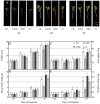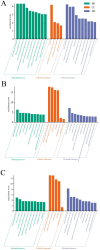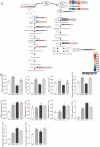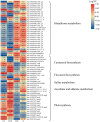Transcriptome Analysis Reveals the Mechanism of Exogenous Selenium in Alleviating Cadmium Stress in Purple Flowering Stalks (Brassica campestris var. purpuraria)
- PMID: 38339079
- PMCID: PMC10855379
- DOI: 10.3390/ijms25031800
Transcriptome Analysis Reveals the Mechanism of Exogenous Selenium in Alleviating Cadmium Stress in Purple Flowering Stalks (Brassica campestris var. purpuraria)
Abstract
In China, cadmium (Cd) stress has a significant role in limiting the development and productivity of purple flowering stalks (Brassica campestris var. purpuraria). Exogenous selenium supplementation has been demonstrated in earlier research to mitigate the effects of Cd stress in a range of plant species; nevertheless, the physiological and molecular processes by which exogenous selenium increases vegetable shoots' resistance to Cd stress remain unclear. Purple flowering stalks (Brassica campestris var. purpuraria) were chosen as the study subject to examine the effects of treatment with sodium selenite (Na2SeO3) on the physiology and transcriptome alterations of cadmium stress. Purple flowering stalk leaves treated with exogenous selenium had higher glutathione content, photosynthetic capacity, and antioxidant enzyme activities compared to the leaves treated with Cd stress alone. Conversely, the contents of proline, soluble proteins, soluble sugars, malondialdehyde, and intercellular CO2 concentration tended to decrease. Transcriptome analysis revealed that 2643 differentially expressed genes (DEGs) were implicated in the response of exogenous selenium treatment to Cd stress. The metabolic pathways associated with flavonoid production, carotenoid synthesis, glutathione metabolism, and glucosinolate biosynthesis were among those enriched in these differentially expressed genes. Furthermore, we discovered DEGs connected to the production route of glucosinolates. This work sheds fresh light on how purple flowering stalks' tolerance to cadmium stress is improved by exogenous selenium.
Keywords: antioxidant enzymes; cadmium; cadmium-responsive genes; glucosinolate metabolism; photosynthetic; purple flowering stalks (Brassica campestris var. purpuraria); selenium.
Conflict of interest statement
The authors declare no conflicts of interest.
Figures










Similar articles
-
Physiological and transcriptomic analysis of purple flowering stalks (Brassica campestris var. purpurea) under cadmium stress and exogenous glutathione application.Plant Physiol Biochem. 2025 Feb;219:109424. doi: 10.1016/j.plaphy.2024.109424. Epub 2024 Dec 18. Plant Physiol Biochem. 2025. PMID: 39721184
-
Variation in the Main Health-Promoting Compounds and Antioxidant Activity of Different Edible Parts of Purple Flowering Stalks (Brassica campestris var. purpuraria) and Green Flowering Stalks (Brassica campestris var. campestris).Plants (Basel). 2022 Jun 23;11(13):1664. doi: 10.3390/plants11131664. Plants (Basel). 2022. PMID: 35807615 Free PMC article.
-
Abscisic acid treatment alleviates cadmium toxicity in purple flowering stalk (Brassica campestris L. ssp. chinensis var. purpurea Hort.) seedlings.Plant Physiol Biochem. 2017 Sep;118:471-478. doi: 10.1016/j.plaphy.2017.07.018. Epub 2017 Jul 20. Plant Physiol Biochem. 2017. PMID: 28755629
-
The regulatory metabolic networks of the Brassica campestris L. hairy roots in response to cadmium stress revealed from proteome studies combined with a transcriptome analysis.Ecotoxicol Environ Saf. 2023 Sep 15;263:115214. doi: 10.1016/j.ecoenv.2023.115214. Epub 2023 Jul 5. Ecotoxicol Environ Saf. 2023. PMID: 37413944
-
Comparison of foliar silicon and selenium on cadmium absorption, compartmentation, translocation and the antioxidant system in Chinese flowering cabbage.Ecotoxicol Environ Saf. 2018 Dec 30;166:157-164. doi: 10.1016/j.ecoenv.2018.09.085. Epub 2018 Sep 26. Ecotoxicol Environ Saf. 2018. PMID: 30267988
Cited by
-
Exogenous selenium enhances cadmium stress tolerance by improving physiological characteristics of Artemisia argyi seedlings.Sci Rep. 2025 Jan 27;15(1):3450. doi: 10.1038/s41598-025-87340-w. Sci Rep. 2025. PMID: 39870703 Free PMC article.
-
Application of Zinc Oxide Nanoparticles to Mitigate Cadmium Toxicity: Mechanisms and Future Prospects.Plants (Basel). 2024 Jun 19;13(12):1706. doi: 10.3390/plants13121706. Plants (Basel). 2024. PMID: 38931138 Free PMC article. Review.
References
-
- Wang Y., Di H., Cheng W., Ren G., Luo S., Ma J., Ma W., Lian H., Li X., Huang Z., et al. Variation in the main health-promoting compounds and antioxidant activity of different edible parts of purple flowering stalks (Brassica campestris var. Purpuraria) and green flowering stalks (Brassica campestris var. Campestris) Plants. 2022;11:1664. doi: 10.3390/plants11131664. - DOI - PMC - PubMed
-
- Qiu Q., Wang Y., Yang Z., Xin J., Yuan J., Wang J., Xin G. Responses of different chinese flowering cabbage (Brassica parachinensis L.) cultivars to cadmium and lead exposure: Screening for cd + pb pollution-safe cultivars. Clean. 2011;39:925–932.
-
- An M., Hong D., Chang D., Wang K., Fan H. Cadmium distribution and migration as influenced by polymer modifiers in a loam soil. Rev. Chim. 2020;71:633–645. doi: 10.37358/RC.20.4.8103. - DOI
MeSH terms
Substances
Grants and funding
LinkOut - more resources
Full Text Sources

